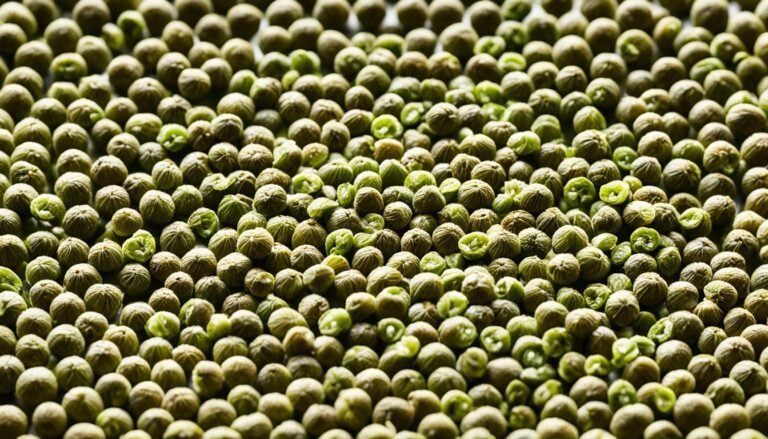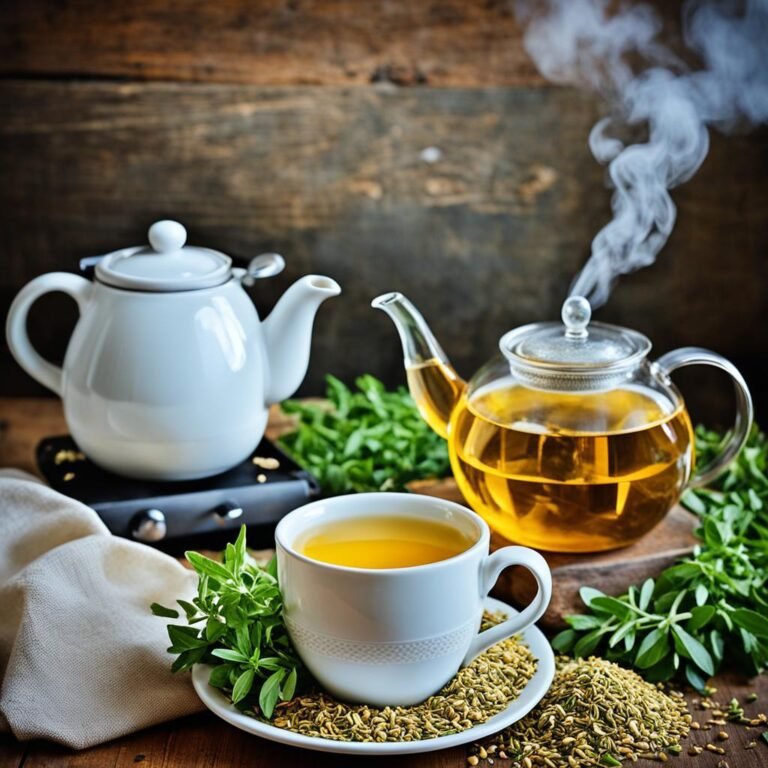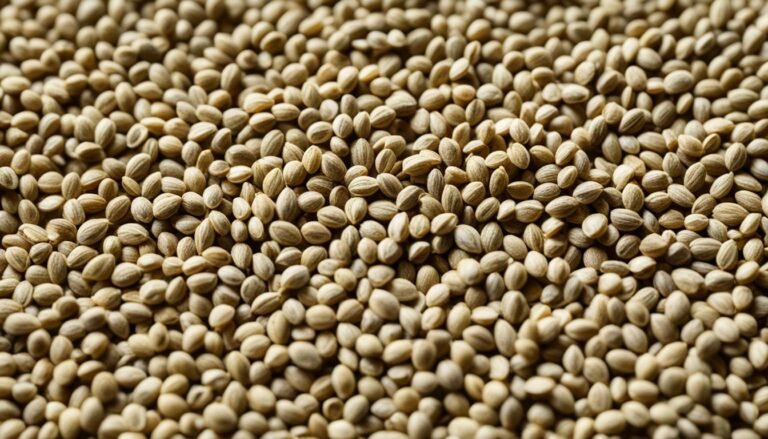Grow Chamomile Seeds: Your Guide to Herbal Bliss
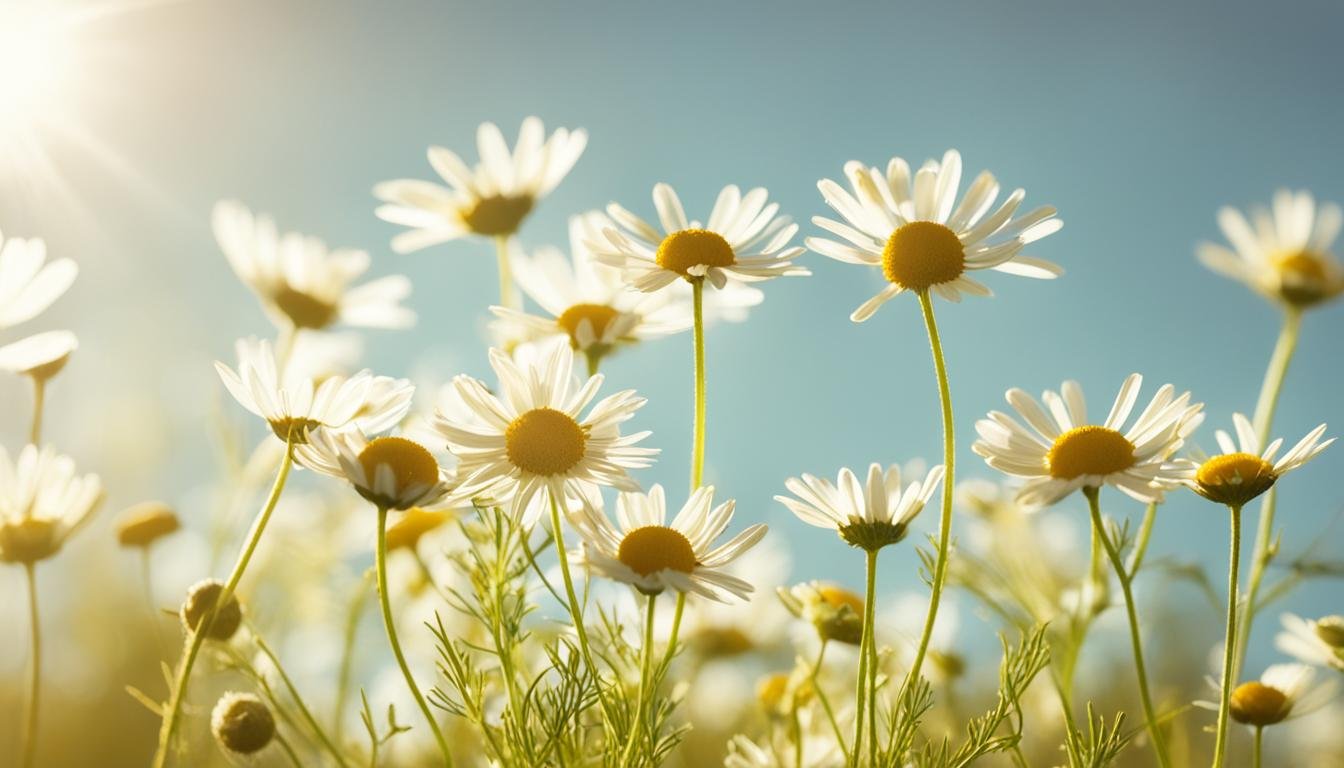
Chamomile, known as Matricaria chamomilla, belongs to the Asteraceae family. It’s a small but powerful herb with a long history in traditional medicine. This guide will help you grow chamomile seeds in your garden. You’ll learn how to enjoy its health benefits and many uses.
Chamomile is full of azulene, a special essential oil. If you want to make a calming tea, use chamomile’s natural remedies, or add it to your garden, this guide is for you. It gives you all the info you need for a journey into herbal bliss.
Chamomile: A Humble Daisy with a Mighty Presence
Chamomile is a beloved herb known for its white daisy-like petals and yellow center. It can grow up to 24 inches tall, thriving in full sun. You can find it in disturbed areas, near roads, and in fields as a weed.
Botanical Description and Habitat
The chamomile plant is a low-growing annual or perennial. It has feathery leaves and a sturdy stem. Its flowers look like miniature daisies, with white petals and a yellow center.
This herb is native to Europe and western Asia. But it has spread to many parts of the world, growing in different soils and climates.
Health Benefits of Chamomile
- Anti-inflammatory properties: Chamomile has compounds that can reduce inflammation. This makes it a natural choice for easing pain.
- Antimicrobial and antispasmodic effects: It also has antimicrobial and antispasmodic properties. These can help with digestion and relaxation.
- Promotion of relaxation and sleep: Chamomile is known for its calming effects. It’s often used to reduce stress, anxiety, and help with sleep.
Chamomile is valued for its many health benefits. It can soothe digestive issues and help you relax and sleep better.
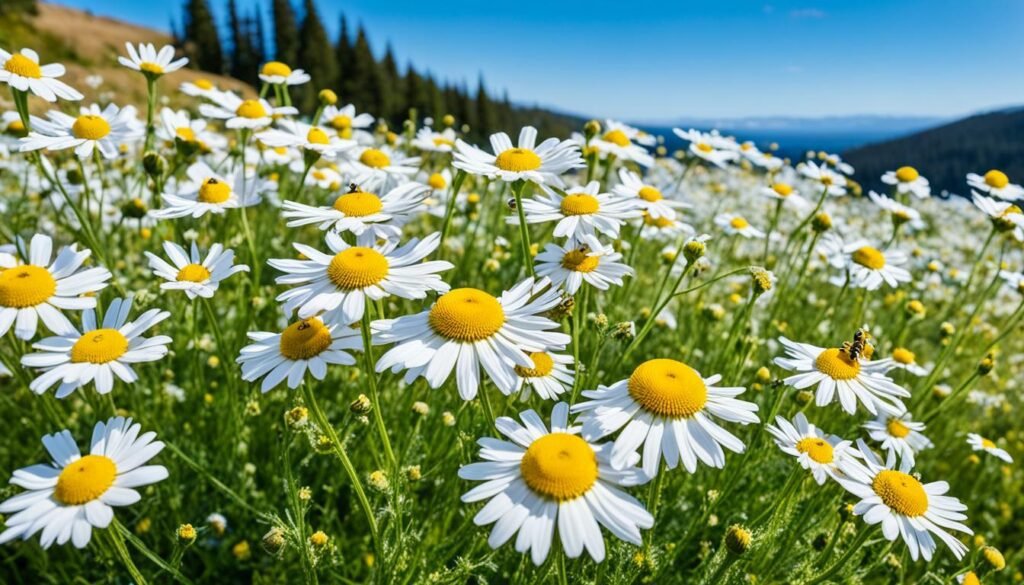
Cultivating Your Own Chamomile Garden
Grow your own chamomile and enjoy its calming effects. Whether starting with chamomile seeds or young plants, you need to know a few things. This will help your chamomile garden flourish.
Climate and Soil Requirements
Chamomile loves full sun and dry, well-drained soil. Pick a spot that gets at least 6 hours of sunlight a day. The soil should be rich in nutrients and a bit acidic, draining well. Stay away from heavy clay or sand, as they can slow down chamomile’s growth.
Planting and Caring for Chamomile Seeds
The best time to plant chamomile seeds is early spring or late fall. Put the tiny seeds directly into the ground, about 3-4 per square inch. Press them gently into the soil since they need sunlight to grow. When the seedlings come up, thin them to give each plant about 1 square inch of space.
Chamomile needs moderate water, so water it once a week. Adjust this based on the weather. Feed it in spring with some organic compost to keep it healthy all season.
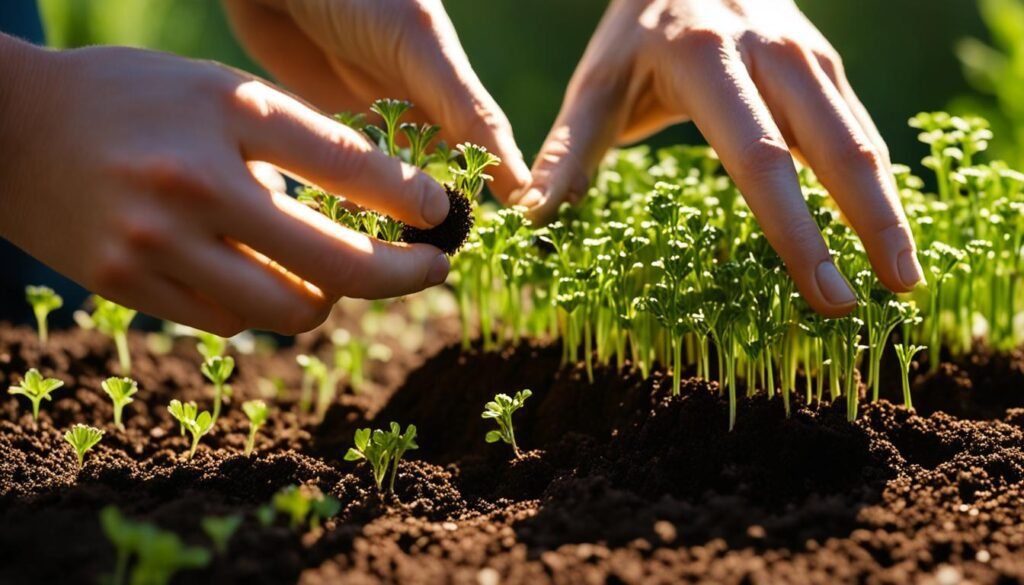
With the right soil conditions and sun exposure, your chamomile will do great. It will give you lots of fragrant flowers. Taking care of it, like watering and weeding, will make sure you have a lot of chamomile to enjoy.
Companion Planting for Chamomile Seeds
Chamomile is a great plant for both herb and vegetable gardens. It grows well with other herbs and vegetables, making them healthier and tastier. This flower attracts good bugs and keeps away pests, making your garden better.
Herbs and Vegetables to Grow with Chamomile
- Herbs: Basil, oregano, chives
- Vegetables: Tomatoes, cucumbers, cabbage
- Perennials: Roses, lilacs, ninebarks, dogwood
- Annuals: Zinnias, petunias, snapdragons, verbena
Chamomile’s scent can hide the smell of veggies like broccoli and cabbage, keeping away pests. It also draws in helpful insects like bees and ladybugs. These bugs help control pests in your garden.
Plants to Avoid Planting Near Chamomile
Chamomile is a good plant to have around, but don’t put it with fennel and dill. These plants can harm chamomile’s growth and taste.
| Beneficial Companion Plants | Plants to Avoid |
|---|---|
| Basil, oregano, chives, tomatoes, cucumbers, cabbage, roses, lilacs, ninebarks, dogwood, zinnias, petunias, snapdragons, verbena | Fennel, dill |
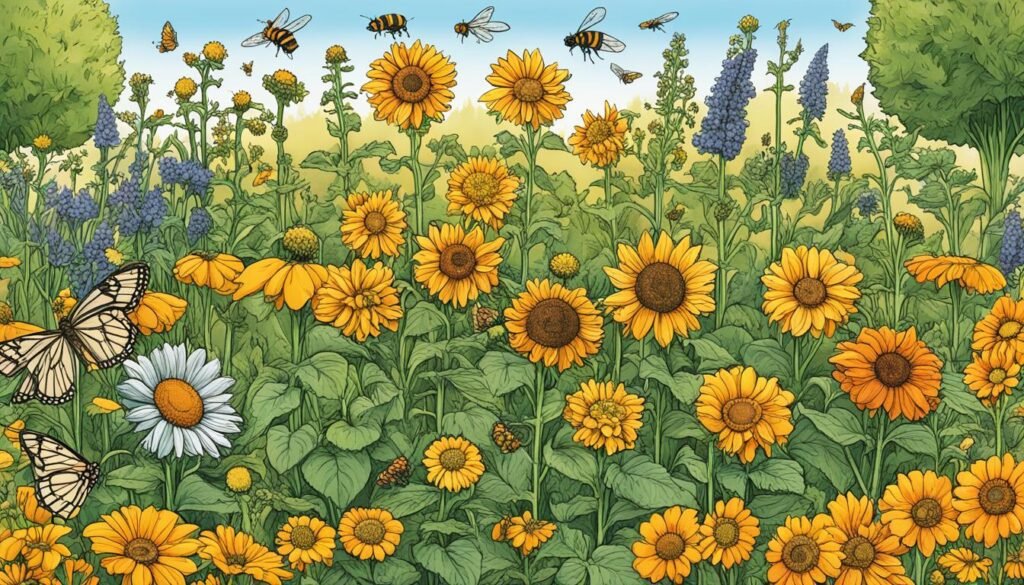
Choosing the right plants for your chamomile can make your garden better. You’ll get a garden that’s full of life, fights pests, and tastes great.
Chamomile Seeds: A Versatile Herb
Chamomile is more than just a pretty garden plant. It’s a powerhouse in many areas, from making calming tea to skincare and aromatherapy. This simple daisy is full of benefits.
The dried flowers of chamomile are often used in teas. They taste like apples and are good for your health. They help with inflammation, digestion issues, and stress, making them a great natural remedy.
Chamomile essential oils are big in aromatherapy. They help calm you down and reduce anxiety. You can use them in diffusers, lotions, or skincare products. They’re also good for your skin because they fight inflammation and germs.
Chamomile can be used in many ways, like making tea, using essential oils, or in skincare. Its many uses show how versatile chamomile seeds are. Try using this plant to improve your health and well-being.
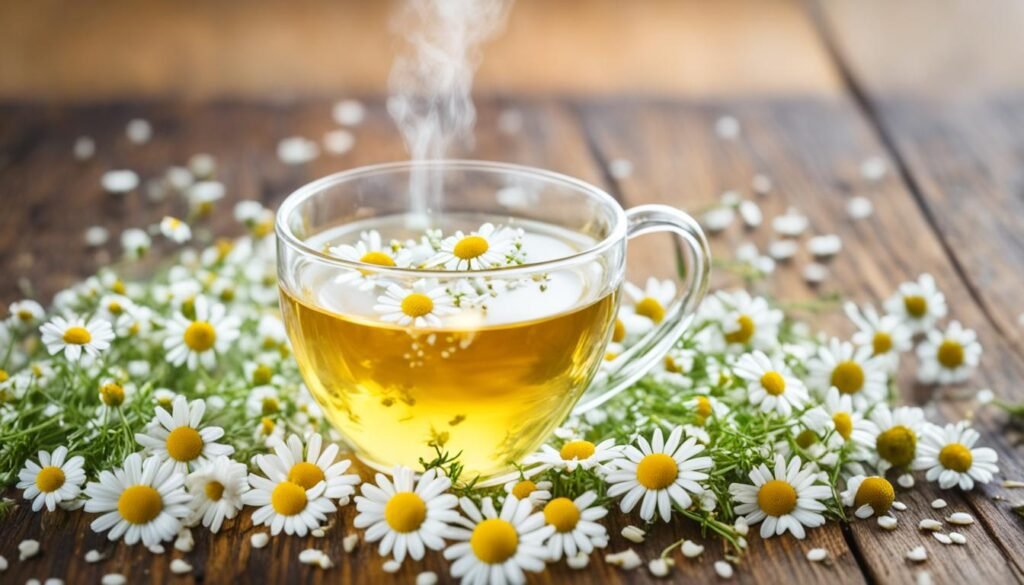
Harvesting and Preserving Chamomile Blossoms
Growing your own chamomile garden is rewarding. The best part is when you pick the fragrant blossoms. Harvest them in late summer or early fall, when they’re fully open and the yellow centers are mature. Cut the whole flower head carefully to avoid harming the plant.
When to Harvest Chamomile
Harvesting starts in mid-July and goes through summer. Pick the flowers in the morning, after the dew dries and before the sun gets too strong. Only take the blossoms, leaving the stems, leaves, and roots. This keeps the essential oils and aromas for tea or remedies.
Drying and Storing Chamomile Flowers
- Put the chamomile flowers in a cool, dry place with good air flow, like a shaded area or a dehydrator.
- It might take 1 to 2 weeks for the flowers to dry, or 12 to 18 hours in a dehydrator on the lowest setting.
- Once dry, store them in airtight containers or sealed bags to keep their flavor and potency.
By following these steps, you can have a great chamomile harvest. Proper drying chamomile and storing chamomile flowers keeps their aroma and healing properties.
The Folklore and History of Chamomile
Chamomile has a long and fascinating history. It’s been part of the traditions of many ancient civilizations. The ancient Greeks, Egyptians, and Anglo-Saxons all saw its value for health.
They used it to help women, preserve bodies, and as one of nine sacred herbs.
In ancient Egypt, chamomile was a treasure. It was linked to the sun god Ra and was known for healing and beauty. Egyptians made chamomile tea to ease stomach issues, ease headaches, and calm nerves.
It was also used in rituals to help spirits move on after death.
The ancient Greeks and Romans called it “Matricaria.” They valued it for its healing and nurturing qualities. They used it to clean wounds, speed up healing, and fight infections.
They even put chamomile garlands on statues of gods to ask for blessings.
Herbalists in the Middle Ages kept using chamomile. They thought it could keep evil spirits away and make people feel better. They hung it over doors to keep out bad vibes and grew it in gardens to keep pests away and improve soil.
Today, chamomile is still loved for its calming scent, relaxing effects, and many uses. It’s in herbal tea, skincare, and natural medicine. Its long history shows its important role in herbal folklore and traditional medicine.
Chamomile Tea: A Soothing Herbal Infusion
Making a cup of chamomile tea is easy and brings many health benefits. Chamomile tea is known for calming and soothing effects. It’s great for relaxation and helping with sleep. It also helps with digestion thanks to its anti-inflammatory and antimicrobial properties.
Health Benefits of Chamomile Tea
Studies show that chamomile tea can ease anxiety, stress, and cold symptoms. It might also boost heart health, improve digestion, and fight cancer. People love the great taste and quality of chamomile tea, showing its popularity.
Brewing the Perfect Cup of Chamomile Tea
To make the best chamomile tea, use 1-2 teaspoons of dried chamomile flowers per cup of hot water. Let it steep for 5-7 minutes. You can drink it plain or add honey for sweetness.
If you want relaxation, better sleep, or improved digestive health, try a cup of chamomile tea. It’s a simple, tasty way to enjoy the benefits of this herbal tea.
Organic and Fair Trade: Our Commitment to Sustainability
At Sacred Plant Co., we focus on organic farming and fair trade for our chamomile flowers. We know that healthy ecosystems and the well-being of farmers are key. By picking organic, we avoid harmful chemicals and help the soil, water, pollinators, and biodiversity.
Our fair trade deals make sure farmers get fair pay and respect. This matches our environmental stewardship and social care. We’re happy to offer products that help your health and support good farming and communities.
| Sustainable Practices | Percentage of Organic Chamomile Seeds | Ratio of Fair Trade to Conventional Chamomile Seeds |
|---|---|---|
| Sacred Plant Co. | 100% | 1:1 |
| Industry Average | 40% | 1:5 |
When you pick organic and fair trade chamomile from Sacred Plant Co., you support a brand that cares for the earth and its people. You’re choosing a company that values sustainability and ethics.
Chamomile in Skincare and Aromatherapy
Chamomile is more than just a tasty tea or a medicine. It’s also great for chamomile skincare and aromatherapy. Its anti-inflammatory and antibacterial qualities help with skin problems. The calming scent of chamomile essential oil can also help you relax.
Using chamomile in your skincare or through aromatherapy is a gentle way to improve your beauty routine. It can soothe skin issues and help you feel calm. Chamomile is a key ingredient in holistic self-care.
| Chamomile Essential Oil Variety | Price (USD) |
|---|---|
| German Chamomile | $15.97 |
| Blue Chamomile | $11.97 |
| Roman Chamomile | $26.97 |
| Cape Chamomile | $24.97 |
| Wild Chamomile | $14.97 |
Natural products like chamomile have helped find new medicines. Research shows how important these extracts are for health.
Chamomile helps with skin issues like eczema and eases sore throats after surgery. It’s a natural way to improve your health. Whether you want to relax or improve your skin, chamomile is a great choice.
Conclusion: Embrace the Herbal Bliss of Chamomile Seeds
Chamomile is a true gem in the world of herbal plants. It offers many benefits for your body and mind. By growing chamomile seeds in your garden, you can enjoy its soothing chamomile tea. You can also use it in many ways and feel the peace and wellness it brings.
Whether you’re an experienced home gardener or just starting, growing chamomile is a journey worth taking. This herb can help you sleep better and soothe skin and stomach issues with its calming properties. It also has anti-inflammatory and antibacterial qualities.
Let’s celebrate the power of this amazing plant and the happiness of having a chamomile garden. Embrace the herbal bliss of chamomile seeds. Discover the many benefits this simple flower can add to your life.
FAQ
What is chamomile, and what are its key botanical features?
Chamomile is known scientifically as Matricaria chamomilla and belongs to the Asteraceae family. It’s a small herb with a big history in traditional medicine. It has white daisy-like petals and yellow centers.
What are the health benefits of chamomile?
Chamomile is known for its health benefits. It has anti-inflammatory, antimicrobial, and antispasmodic properties. It helps with digestion, relaxation, and sleep.
What are the ideal growing conditions for chamomile seeds?
Chamomile loves full sun and dry, well-drained soil. Plant it in a sunny spot with rich, slightly acidic soil. Sow seeds in early spring or late fall, and keep the soil moist until it grows.
What are some good companion plants for chamomile in the garden?
Chamomile is great with other herbs and veggies. It goes well with basil, oregano, chives, tomatoes, cucumbers, and cabbage. But, don’t plant it near fennel and dill.
How can chamomile be used beyond just growing it in the garden?
Chamomile is versatile. You can make a calming tea with its dried flowers. The essential oil is great for aromatherapy and skincare. It’s also used in natural remedies.
When is the best time to harvest chamomile flowers, and how should they be dried and stored?
Harvest chamomile in late summer or early fall. Cut the whole flower head. Dry them in a cool, dry place, then store in airtight containers to keep them fresh.
What is the history and folklore surrounding chamomile?
Chamomile has a long history in many cultures. The ancient Greeks, Egyptians, and Anglo-Saxons valued it for its health benefits. They used it for women’s health, mummification, and as a sacred herb.
What are the benefits of brewing a cup of chamomile tea?
Drinking chamomile tea is great for relaxation and sleep. It’s calming and supports digestive health. It also has anti-inflammatory and antimicrobial properties.
What is Sacred Plant Co.’s commitment to sourcing chamomile flowers?
Sacred Plant Co. sources chamomile through organic and fair trade. We support sustainable farming and the farmers who grow our herbs. Organic farming means no harmful chemicals and better soil, water, and wildlife.
How can chamomile be used in skincare and aromatherapy?
Chamomile is great for skincare and aromatherapy. Its anti-inflammatory and antibacterial properties help with skin issues. Its calming scent is used in essential oils and diffusers for relaxation.

